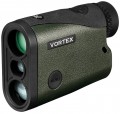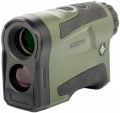Magnification
The degree of magnification provided by the rangefinder. The parameter indicates how many times the images of visible objects in the field of view of the device will be larger than they actually appear to the naked eye. For example, through a rangefinder window with a 6x magnification, the object will look six times closer.
As a rule, the optics of hunting rangefinders have a magnification of
6x,
7x, less often -
>7x. This is quite enough to determine the distance to a target within a kilometer. Higher magnification ratios are found in military rangefinders and special-purpose devices.
Measurement range
The range of distances at which a rangefinder can accurately measure the distance to a target. This interval can vary from a few meters to several kilometers. For hunting, a rangefinder with a maximum measurement distance of up to 1000 or 1500 meters is often sufficient. However, for long-range precision shooting, it’s worth considering models with a longer "reach" to the target. Additionally, keep in mind that the measurement range depends on the size of the object, the reflectivity of surfaces, and weather conditions.
Field of view at 1000 m
The viewing width in meters that can be seen through the device at a distance of 1000 m. This parameter is often indicated by the abbreviation FOV at 1000m (Field of View at 1000 meters). A wide field of view allows you to see a larger area of the terrain, making it easier to find and observe targets. However, its growth entails a decrease in the magnification factor, which may be undesirable when shooting at long distances.
Accuracy
Accuracy of measurements provided by a rangefinder for shooting. The parameter is usually indicated by the error - the largest deviation of the measurement results from the actual distance to the target. It is written as ±0.5m or +/-1 m per 1000 m. The smaller the error, the more accurate the result.
Lens diameter
The diameter of the objective lens in a rangefinder for shooting. The larger its size, the higher the aperture ratio and sensitivity of the device. This provides the ability to observe a target or target in low light. The optics in rangefinders usually have a diameter of 20 to 25 mm. A lens that is too large increases the weight and cost of the entire device.
Features
—
Determining the target angle. Target angle takes into account the difference between the horizontal distance to an object and the actual distance to it if the target is on high or low terrain. The corresponding correction is introduced so that it is possible to accurately shoot at long distances up or down steep slopes. Rangefinders with this function are able to measure the actual horizontal distance to the target, taking into account the terrain.
—
Ballistic calculator. Such a calculator helps the shooter more accurately calculate the ballistic correction, taking into account the distance to the target, its angle, wind speed and other parameters that affect the trajectory of the bullet. In advanced rangefinder models, you can enter data on the type of bullet, shot speed, ammunition weight and other ballistic parameters to accurately calculate the flight path. Also, many modern rangefinders with a ballistic calculator can provide automatic corrections for accurate shooting without the need to calculate the data manually.
—
Scan mode. A function that allows you to measure distances not only to one point, but to various objects or targets in the selected area. The SCAN scanning mode makes it possible to estimate distances to several targets or objects simultaneously without the need to restart the measurement each time. It is also used to determine dis
...tances to multiple obstacles, which can be useful when choosing the optimal route. While tracking a moving target, the scanning mode helps to continuously update the distance to it, which makes it easier to keep the object in the affected area. Scan mode specifications may vary depending on the model and brand of shooting rangefinder.
— Archer mode. This mode provides the shooter with the critical data needed to accurately hit a target when using a bow. It allows you to estimate the distance to the target, taking into account the specifics of bow shooting. In Archer Mode (Bow Mode), the angle of inclination to the target is taken into account, which is important for correct sight correction, arrow speed and other parameters that affect the flight path of the projectile for shooting.
— Flag mode (for golf). A dedicated mode for golfers to help them measure distances on the golf course more accurately and make better decisions while playing. Rangefinders with this function provide information about the distance to different points on the field, and can take into account wind speed and elevation changes, which often become decisive factors in determining the correct game strategy.
— Speed measurement. Thanks to this function, the rangefinder allows you to determine not only the distance to the target, but also the speed of its movement. The mode for measuring the speed of a moving target helps you choose the right lead for shooting. Typically, the resulting speed reading is displayed on the rangefinder display, allowing the shooter to see the target's current speed in real time.
— Measurement during precipitation. A specialized RAIN mode is used to more accurately measure the distance to a target, taking into account the influence of atmospheric factors (rain, snow, fog, etc.). It makes automatic corrections related to light scattering in adverse weather conditions. Precipitation mode is useful when visibility and measurement accuracy may be difficult.
— Measuring a nearby target. The ability of the device to determine the distance to an object that is close to the shooter. In cases where several objects at different distances simultaneously fall into the laser field of action, the device shows the distance to the nearest one. Measuring the shortest distance to the nearest target allows you to avoid misses and choose the best place to shoot.
— Measuring a distant target (through branches). A mode that allows you to accurately determine the distance to distant objects. It does not take into account reflections from nearby obstacles, such as bush branches. As a result, the shooter can fully concentrate on the target or a target that is located at a great distance.
— Selecting the type of aiming mark. The device has several options for aiming marks at once, with the ability to switch between them. This feature allows the shooter to choose the most convenient option depending on the characteristics of the situation and personal preferences. It is important to note that the full ability to switch between reticles is found only in devices with an electronic operating principle. In classical optics, this function is used extremely rarely, and in a stripped-down version: in addition to the usual (unchangeable) grid, the user can include a mark in the form of a dot.
— Illuminated aiming mark. The presence in the rangefinder of a special illumination for the aiming mark, which is usually either a light mark on the lens or a set of pixels on the screen. For traditional optics, this feature is far from mandatory and is intended mainly for specific cases - for example, when a dark target is against a dark background, which is why the unilluminated reticle becomes almost invisible. It is worth considering that the backlight usually requires a battery to operate. There are also systems that do not require power (tritium backlight), but they are practically never found in civilian models of rangefinders.
— Backlight brightness adjustments. Ability to adjust the brightness with which the reticle is illuminated. Such adjustment can be provided in all types of rangefinders with backlight (see above). It allows you to optimally adjust the backlight to the specifics of the situation: for example, if the background in the field of view of the optics is very dark, a too bright reticle will “harm the eye” against its background. And in some situations in bright sunlight, maximum brightness may be required - otherwise the mark will be difficult to see.
- Compass. The presence of a compass in the design of the rangefinder for shooting. A compass can be useful for navigating the terrain, especially when staying away from civilization - for example, during hunting. In most cases, it is made in the form of a separate scale with an arrow installed in the upper part of the device body. In the most advanced devices, the compass scale is superimposed directly on the image visible in the eyepiece - this is very convenient when determining azimuths for individual objects. A compass is also found in advanced rangefinder models that transmit data to a smartphone or riflescope - this function can be useful for determining the direction to a target or its position on the ground (including linking it to a map in a mobile phone application).
— Barometer. The presence of a sensor in the design of the rangefinder for measuring the level of atmospheric pressure. The barometer can provide information about upcoming weather changes by indicating approaching low or high pressure, and it can also be used to adjust distance measurements based on the shooter's current altitude. Some rangefinders use data from a built-in barometer to predict the effect of atmospheric pressure on bullet flight over long ranges. This helps the shooter make more accurate shooting adjustments.
- Hygrometer. Sensor for measuring relative humidity in the environment. The hygrometer in the rangefinder allows the shooter to obtain information about air humidity, which can be useful in assessing weather conditions and their impact on shooting. At the same time, high humidity often affects the density of air, making it less dense for laser radiation. As a result, the beam may travel further than expected. A hygrometer often takes this factor into account and provides corrected distance to a target or target based on the relative humidity of the air.
- Thermometer. The presence of a built-in thermometer on board the rangefinder for shooting. The temperature measurement sensor helps take into account air density factors when shooting over long distances, allows you to assess how active or passive animals can be during a hunt, and is used to assess weather conditions.
- Synchronization. The ability to synchronize the rangefinder with a weapon sight for more accurate targeting depending on the measured distance, a weather station for obtaining weather information, and a mobile application on a smartphone. Moreover, both individually and in several versions at once. Shooting rangefinders usually communicate with mobile gadgets via the Bluetooth wireless protocol. The program allows you to fine-tune the operating parameters of the device.Power source
The type of power used in the shooting rangefinder. The most widespread in this regard are replaceable batteries of one size or another, and most often they are not included in the kit. At first glance, this is not very convenient, but this configuration gives the user the opportunity to choose batteries at his own discretion based on price, quality and type (batteries or accumulators). Also, some rangefinder models are powered
by a built-in battery. This solution eliminates the need to purchase batteries, however, recharging is carried out much more often than replacing disposable power supplies.

